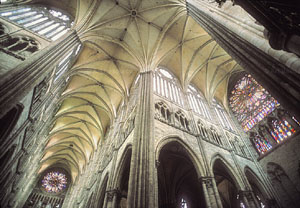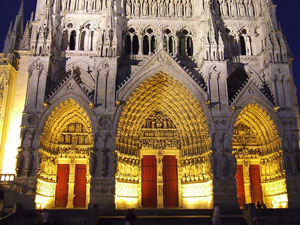 |
Stories & Legends
The Medievals Were Barbarians …
Hugh O’Reilly
It is hard to believe today that in the 17th and 18th centuries - and even later - the term “gothic” was considered equivalent to “barbarian.” We would be much more inclined to marvel at all that was built in those “barbarian” times using means and tools that were much simpler than those of our days.

Vaulted ceiling and crossing in Amiens Cathedral
Below, portals on the west façade
 |
Specialists calculate that France in the 12th and 13th centuries transported more stones than Egypt when it raised its pyramids. They acknowledge that the foundations of the medieval French cathedrals on the average reach the depths of our metro stations. They were astounded to learn that in Amiens, the cathedral was large enough to hold the whole population of the city. Today, the grand stadiums constructed in cities like New York or Paris can only contain a very small part of their population. The effort made by the inhabitants of Amiens in the 13th century to erect its cathedral was, therefore, proportionally much superior to what we construct today to serve a large city.
Some contemporary technicians did a research involving very complicated calculations. If we situate ourselves from the architectural point of view, we understand that in a construction everything that is solid – the walls, ceiling, etc. – is expensive, because the solid parts are made of materials costly to transport, costly to build, costly to work with. The most skillful architecture is, therefore, that which encompasses the greatest amount of empty space with the minimum of solid parts – as long as it provides the same solidity, naturally.
Now, in Notre Dame of Paris, the solid parts occupy no more than one-seventh of the total volume of the cathedral: this includes everything – the arches, walls, pillars, columns, etc. In Saint Peter’s Basilica in Rome, the architectural masterpiece of the Renaissance where the most famous artists of the time such as Bramante, Raphael and Michelangelo worked, the solid parts occupy one-fourth of the total space. It hardly needs saying that Notre Dame combines the maximum of lightness with the maximum of solidity.
Thus it is that as we come to know the Middle Ages better, it presents itself to us more and more as a very grand epoch, including from the technical point of view: an epoch full of surprises and an incomparable beauty.
It is time to reach the point where these beauties of the Middle Ages are completely recognized and investigated. The interest of the generations that preceded us were directed above all to the times of Antiquity – Greece, Rome, Egypt – to such a point that our past was quite literally forgotten. It suffices to see that our school programs are set up as if nothing of interest took place during those 1,000 years that are called the Middle Ages A rapid glance at those 1,000 years in secondary school is considered sufficient. And, yet how many know that only the vestiges of the 12th and 13trh centuries are more numerous on our French soil than those of all the other centuries combined?

Selected and translated from
Régine Pernoud, Beauté du Moyen Age,
Gautier-Languereau, 1971, pp. 7-9
Posted February 28, 2009


Related Topics of Interest
 The cathedral was a symbol of Paradise The cathedral was a symbol of Paradise
 The Middle Ages, a forest filled with symbols The Middle Ages, a forest filled with symbols
 Requiescant in pace... - Burial customs Requiescant in pace... - Burial customs
 The symbol of the sword The symbol of the sword
 The fidelity of the remnant throughout History The fidelity of the remnant throughout History
 Gargoyles and original sin Gargoyles and original sin
 Virtue and vice symbolized in animals Virtue and vice symbolized in animals
 The prayers of a knight The prayers of a knight

Related Works of Interest
|
|
Legends | Religious |
Home | Books | CDs | Search | Contact Us | Donate

© 2002-
Tradition in Action, Inc. All Rights Reserved
|
 |
|